Suche
Neu
- MERRY X-MAS (cla_rei, 23.Dec.10)
- SHANGHAI'S YESTERDAY, TODAY AND TOMORROW (cla_rei, 13.Dec.10)
- ON SITE CLOSE UP (cla_rei, 13.Dec.10)
- IN THE SPOTLIGHT FOR ONE MOMENT (cla_rei, 13.Dec.10)
- CONSTRUCTION LOOPS IN SHANGHAI (cla_rei, 13.Dec.10)
Links
Navigation
Meta
Archiv
- December 2025MonTueWedThuFriSatSun12345678910111213141516171819202122232425262728293031
RSS
Wednesday, 17. November 2010
DARK CLOUDS OVER SHANGHAI
On Monday we were sitting in our apartment not knowing which disaster was happening two streets away – until sirens started howling and wads of smoke darkened the sky. A fire in a high-rise building, the worst in Shanghai in recent years, killed at least 53 people (inofficial number 100) The 85-meter-high residential building at the intersection of Jiaozhou Road and Yuyao Road was home to more than 440 people, mainly retired teachers. According to local newspapers the scaffolding was paved with bamboo boards and surrounded by nylon netting - both highly flammable - which led to the fire spreading quickly.
China already has very strict fire safety regulations for buildings. While we calculate with 30 minutes for the fire brigade to arrive in Europe, the arriving period here is 2 hours. This is one reason why staircases in apartment buildings here look like concrete bunkers.

view from our apartment
China already has very strict fire safety regulations for buildings. While we calculate with 30 minutes for the fire brigade to arrive in Europe, the arriving period here is 2 hours. This is one reason why staircases in apartment buildings here look like concrete bunkers.

view from our apartment
cla_rei am 17. November 10
|
Permalink
|
0 Kommentare
|
kommentieren
SHANGHAI'S YESTERDAY, TODAY AND TOMORROW
In China most of the bigger cities (Beijing, Shanghai, Chongqing) have an Urban Planning Museum, displaying the governmental city planning. The one in Shanghai it is located on the People Square from where you can have a fabulous bird eye view on the city. The Shanghai Urban Planning Exhibition Center not only shows the latest urban development, but also shows Shanghai’s historical development. Centerpiece of the exhibition is a 1:500 city scale model that has to be updated permanently.
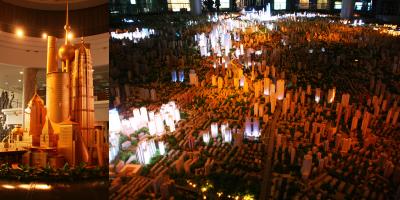
By strongly promoting the transformation of old areas, Shanghai wants to improve the overall quality of housing with newly built apartments. According to the museum 16.2 million m² were constructed for new housing in the last 20 years, which is 53% of the total housing area.
In 2003, per capita living area has reached 13.8 m² and more than 200 excellent living areas with “planning from a high starting point, high-level designing, high-quality construction and high-standard management” were established.
In the last 20 years, Shanghai’s city construction bureau has focused especially on the transformation of old areas. The museum proudly promotes, that “42.81 million m² of shabby and dilapidated houses have been pulled down with over 900.000 households moving into new residences”.
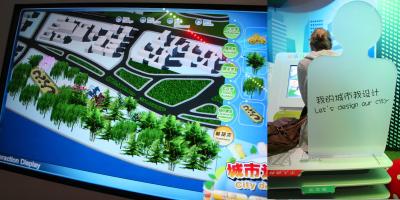
AFTER EXPO - WHAT NOW?
For the expo site after use visitors are invited to propose design ideas. One can choose between sky rise building or office tower. We suggested planting trees following the slogan: Better city - better life!

By strongly promoting the transformation of old areas, Shanghai wants to improve the overall quality of housing with newly built apartments. According to the museum 16.2 million m² were constructed for new housing in the last 20 years, which is 53% of the total housing area.
In 2003, per capita living area has reached 13.8 m² and more than 200 excellent living areas with “planning from a high starting point, high-level designing, high-quality construction and high-standard management” were established.
In the last 20 years, Shanghai’s city construction bureau has focused especially on the transformation of old areas. The museum proudly promotes, that “42.81 million m² of shabby and dilapidated houses have been pulled down with over 900.000 households moving into new residences”.

AFTER EXPO - WHAT NOW?
For the expo site after use visitors are invited to propose design ideas. One can choose between sky rise building or office tower. We suggested planting trees following the slogan: Better city - better life!
cla_rei am 17. November 10
|
Permalink
|
0 Kommentare
|
kommentieren
COUNTING CHINA

The sixth nationwide population census started this month.
China had its first population census in 1953 and since the fourth census in 1990, the census is conducted every decade. The over 6 million voluntary census workers are facing difficulties: Many families are too afraid to open the door because of China’s one child policy or because they are migration workers living in the city without any registration.
For the first time the government is showing interest in the rising number of foreign people living in China. (NY Times, 01.11.2010) So even we were asked in the lobby of our apartment building to participate in the census, although we are only here for two and a half months.
From all we’ve heard and read in the newspapers about this census, China seems to be getting just another fake number of their inhabitants. But anyways, the results of the census are expected to be released in April – just in time for our thesis.
cla_rei am 17. November 10
|
Permalink
|
0 Kommentare
|
kommentieren
Tuesday, 16. November 2010
BECAUSE OF THE EXPO...
With one week to go we arrived at the perfect time for the grand expo-showdown. While the organization was still working on reaching the goal of 70 million visitors (we were told some governmental owned companies threatened their employees with suspension if they don’t visit the expo), many of the pavilion workers were already looking forward to the end of their nerve-racking jobs. On a single day up to 1 Million people visited the Site (on the 16th of October over 1.032.800)!
The waiting time in front of the most favourite pavilions (e.g. Saudi Arabia) was up to eight hours. To avoid the queues and to get an easy access ticket some women even pretend to be pregnant by putting a pillow under their clothes.
Through our friend we were able to experience not only the official exhibitions but also got some very nice insight views on the expo-life of the international community working there. Even after closing hours in this “parallel” world within Shanghai the competition between the countries went on – this time not for the numbers of visitors but for organizing the best parties and which team is staying up the latest – the whole gossip then being discussed on www.exponights.com and the monthly expat-magazines in Shanghai.
Now two weeks later we still see EXPO signs posted on every wall that we pass in the city and printed on every product we buy in the supermarket. Only the widespread explanation “…because of the EXPO” that was used to find an answer to every miracle here has disappeared.
Now they have found a new one: DISNEY LAND - coming in 2015.

The China Pavilion - "The Crown of the East"

The UK Pavilion - "The Seed Cathedral"
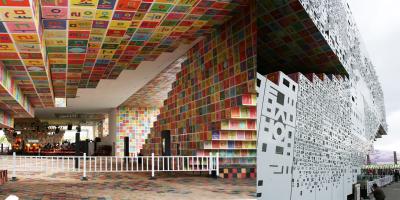
The Republic of Korea Pavilion
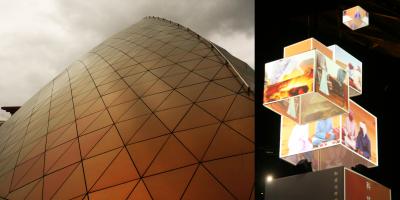
The United Arab Emirates Pavilion - "The Power of Dreams"

"Better City, Better Life" for a better living in future urban
environments.
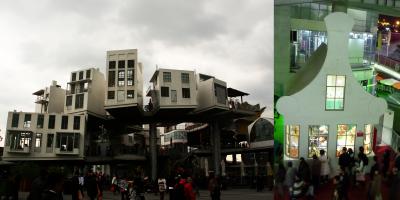
The Dutch Pavilion - "The Happy Street"

The Spain Pavilion

The Denmark Pavilion - "Welfairytales with the Little Mermaid"
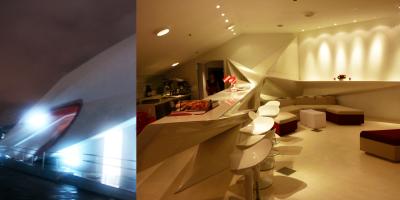
The Austrian Pavilion - "Feel the Harmony"
The waiting time in front of the most favourite pavilions (e.g. Saudi Arabia) was up to eight hours. To avoid the queues and to get an easy access ticket some women even pretend to be pregnant by putting a pillow under their clothes.
Through our friend we were able to experience not only the official exhibitions but also got some very nice insight views on the expo-life of the international community working there. Even after closing hours in this “parallel” world within Shanghai the competition between the countries went on – this time not for the numbers of visitors but for organizing the best parties and which team is staying up the latest – the whole gossip then being discussed on www.exponights.com and the monthly expat-magazines in Shanghai.
Now two weeks later we still see EXPO signs posted on every wall that we pass in the city and printed on every product we buy in the supermarket. Only the widespread explanation “…because of the EXPO” that was used to find an answer to every miracle here has disappeared.
Now they have found a new one: DISNEY LAND - coming in 2015.

The China Pavilion - "The Crown of the East"

The UK Pavilion - "The Seed Cathedral"

The Republic of Korea Pavilion

The United Arab Emirates Pavilion - "The Power of Dreams"

"Better City, Better Life" for a better living in future urban
environments.

The Dutch Pavilion - "The Happy Street"

The Spain Pavilion

The Denmark Pavilion - "Welfairytales with the Little Mermaid"

The Austrian Pavilion - "Feel the Harmony"
cla_rei am 16. November 10
|
Permalink
|
0 Kommentare
|
kommentieren
WORKING MIGRATION IN CHINA - GLOBAL VS. LOCAL
We are two architecture students from the TU Vienna, who are currently doing a research in Shanghai. We are researching about global vs. local work migration in Shanghai's construction industry and want to design an architectual response to the current situation. Of course part of our research is to get to know the city of Shanghai and its everyday life. Here we are posting some impressions we are collecting during our stay in Shanghai.


essential for meetings in China - our business cards
The background illustration by contemporary Chinese artist Yang Yongliang is posted with permission.


essential for meetings in China - our business cards
The background illustration by contemporary Chinese artist Yang Yongliang is posted with permission.
cla_rei am 16. November 10
|
Permalink
|
0 Kommentare
|
kommentieren